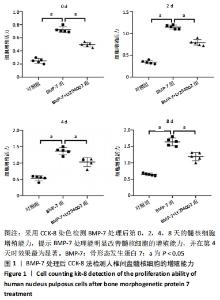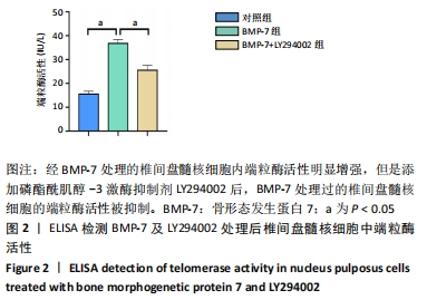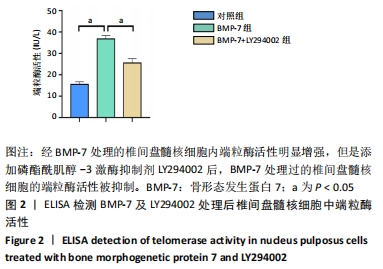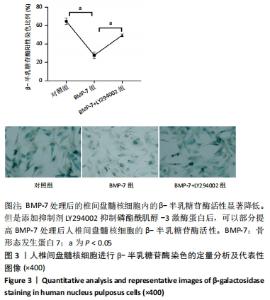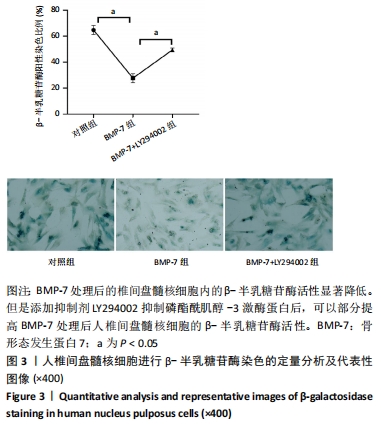Chinese Journal of Tissue Engineering Research ›› 2022, Vol. 26 ›› Issue (17): 2726-2731.doi: 10.12307/2022.542
Previous Articles Next Articles
Bone morphogenetic protein 7 inhibits apoptosis of nucleus pulposus cells
Xu Xuezhen, Song Lixian, Li Aiqun, Yang Jian, Li Xiaokun, Wang Zhanqing, Shi Qingpeng
- Yantai Affiliated Hospital of Binzhou Medical University, Yantai 264100, Shandong Province, China
-
Received:2021-06-15Revised:2021-06-17Accepted:2021-08-14Online:2022-06-18Published:2021-12-27 -
Contact:Shi Qingpeng, Master, Associate chief physician, Yantai Affiliated Hospital of Binzhou Medical University, Yantai 264100, Shandong Province, China -
About author:Xu Xuezhen, Master, Associate chief physician, Yantai Affiliated Hospital of Binzhou Medical University, Yantai 264100, Shandong Province, China -
Supported by:Shandong Provincial Medicine and Health Science and Technology Development Plan, No. 2019WS340 (to XXZ)
CLC Number:
Cite this article
Xu Xuezhen, Song Lixian, Li Aiqun, Yang Jian, Li Xiaokun, Wang Zhanqing, Shi Qingpeng. Bone morphogenetic protein 7 inhibits apoptosis of nucleus pulposus cells[J]. Chinese Journal of Tissue Engineering Research, 2022, 26(17): 2726-2731.
share this article
Add to citation manager EndNote|Reference Manager|ProCite|BibTeX|RefWorks
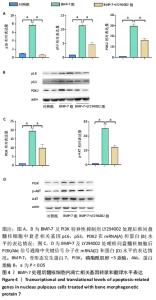
2.4 骨形态发生蛋白7可以调控髓核细胞内衰老相关基因的转录和翻译水平 与对照髓核细胞相比,骨形态发生蛋白7处理后的人椎间盘髓核细胞中,凋亡相关基因p16和p53的mRNA表达均下调,并且骨形态发生蛋白7对p16和p53基因的抑制作用可以被抑制剂LY294002所逆转,见图4A。进一步通过免疫印迹检测衰老标志物的蛋白质表达情况,发现在骨形态发生蛋白7处理的人椎间盘髓核细胞中p16和p53的蛋白质表达均被下调,但是抑制剂LY294002可以提高被抑制的p16和p53的蛋白表达水平,见图4B。同时检测PI3K/Akt信号通路的关键信号分子p-Akt和PI3K,证实骨形态发生蛋白7通过激活PI3K/Akt信号通路参与调控椎间盘髓核细胞的抗凋亡作用,见图4C,D。"

| [1] 邱晨生, 邓念, 相宏飞, 等. 椎间盘退变相关危险因素的研究进展[J]. 中华骨科杂志,2021,41(10):654-659. [2] 陈敏, 赵凯. 椎间盘退变的机制及其治疗方法的研究进展[J]. 按摩与康复医学,2019,10(18):58-60. [3] 余城墙, 张宇, 谢程欣, 等. 椎间盘退变分子生物学机制及再生治疗的优势与未来[J]. 中国组织工程研究,2019,23(30):4889-4896. [4] VADALA G, RUSSO F, De STROBEL F, et al. Novel stepwise model of intervertebral disc degeneration with intact annulus fibrosus to test regeneration strategies. J Orthop Res. 2018;36(9):2460-2468. [5] 陈铭, 沈军. 椎间盘髓核退变再生修复研究和临床应用现状[J]. 南京医科大学学报(自然科学版),2019,39(5):774-780. [6] ZHAO K, AN R, XIANG Q, et al. Acid-sensing ion channels regulate nucleus pulposus cell inflammation and pyroptosis via the NLRP3 inflammasome in intervertebral disc degeneration. Cell Prolif. 2021; 54(1):e12941. [7] WANG W, DENG G, QIU Y, et al. Transplantation of allogenic nucleus pulposus cells attenuates intervertebral disc degeneration by inhibiting apoptosis and increasing migration. Int J Mol Med. 2018;41(5):2553-2564. [8] LIU J, YU J, JIANG W, et al. Targeting of CDKN1B by miR-222-3p may contribute to the development of intervertebral disc degeneration. FEBS Open Bio. 2019;9(4):728-735. [9] MA K, CHEN S, LI Z, et al. Mechanisms of endogenous repair failure during intervertebral disc degeneration. Osteoarthritis Cartilage. 2019;27(1):41-48. [10] WU Q, MATHERS C, WANG EW, et al. TGF-beta Initiates beta-Catenin-Mediated CTGF Secretory Pathway in Old Bovine Nucleus Pulposus Cells: A Potential Mechanism for Intervertebral Disc Degeneration. JBMR Plus. 2019;3(2):e10069. [11] CHEN S, LIU S, MA K, et al. TGF-beta signaling in intervertebral disc health and disease. Osteoarthritis Cartilage. 2019;27(8):1109-1117. [12] KROUWELS A, ILJAS JD, KRAGTEN A, et al. Bone Morphogenetic Proteins for Nucleus Pulposus Regeneration. Int J Mol Sci. 2020; 21(8):2720. [13] LI Z, LANG G, KARFELD-SULZER LS, et al. Heterodimeric BMP-2/7 for nucleus pulposus regeneration-In vitro and ex vivo studies. J Orthop Res. 2017;35(1):51-60. [14] MA K, CHEN S, LI Z, et al. Mechanisms of endogenous repair failure during intervertebral disc degeneration. Osteoarthritis Cartilage. 2019;27(1):41-48. [15] De CICCO FL, CAMINO WG. Nucleus Pulposus Herniation. 2021. [16] TAVAKOLI J, DIWAN AD, TIPPER JL. Elastic fibers: The missing key to improve engineering concepts for reconstruction of the Nucleus Pulposus in the intervertebral disc. Acta Biomater. 2020;113:407-416. [17] MOHANTY S, DAHIA CL. Defects in intervertebral disc and spine during development, degeneration, and pain: New research directions for disc regeneration and therapy. Wiley Interdiscip Rev Dev Biol. 2019;8(4): e343. [18] TANG X, JING L, RICHARDSON WJ, et al. Identifying molecular phenotype of nucleus pulposus cells in human intervertebral disc with aging and degeneration. J Orthop Res. 2016;34(8):1316-1326. [19] WU H, SHANG Y, YU J, et al. Regenerative potential of human nucleus pulposus resident stem/progenitor cells declines with ageing and intervertebral disc degeneration. Int J Mol Med. 2018;42(4):2193-2202. [20] ZHAO R, LIU W, XIA T, et al. Disordered Mechanical Stress and Tissue Engineering Therapies in Intervertebral Disc Degeneration. Polymers (Basel). 2019;11(7):1151. [21] GE J, CHENG X, YUAN C, et al. Syndecan-4 is a Novel Therapeutic Target for Intervertebral Disc Degeneration via Suppressing JNK/p53 Pathway. Int J Biol Sci. 2020;16(5):766-776. [22] LEUNG VYL, ZHOU L, TAM WK, et al. Bone morphogenetic protein-2 and -7 mediate the anabolic function of nucleus pulposus cells with discrete mechanisms. Connect Tissue Res. 2017;58(6):573-585. [23] GU T, SHI Z, WANG C, et al. Human bone morphogenetic protein 7 transfected nucleus pulposus cells delay the degeneration of intervertebral disc in dogs. J Orthop Res. 2017;35(6):1311-1322. [24] KIM JS, ELLMAN MB, AN HS, et al. Insulin-like growth factor 1 synergizes with bone morphogenetic protein 7-mediated anabolism in bovine intervertebral disc cells. Arthritis Rheum. 2010;62(12):3706-3715. [25] WANG C, RUAN DK, ZHANG C, et al. Effects of adeno-associated virus-2-mediated human BMP-7 gene transfection on the phenotype of nucleus pulposus cells. J Orthop Res. 2011;29(6):838-845. [26] WANG Z, HUTTON WC, YOON ST. The effect of capacitively coupled (CC) electrical stimulation on human disc nucleus pulposus cells and the relationship between CC and BMP-7. Eur Spine J. 2017;26(1):240-247. [27] LI XC, WU YH, BAI XD, et al. BMP7-Based Functionalized Self-Assembling Peptides Protect Nucleus Pulposus-Derived Stem Cells From Apoptosis In Vitro. Tissue Eng Part A. 2016;22(19-20):1218-1228. [28] CHAOFENG W, CHAO Z, DELI W, et al. Nucleus pulposus cells expressing hBMP7 can prevent the degeneration of allogenic IVD in a canine transplantation model. J Orthop Res. 2013;31(9):1366-1373. [29] YANG P, TRONCONE L, AUGUR ZM, et al. The role of bone morphogenetic protein signaling in vascular calcification. Bone. 2020;141:115542. [30] SAMPATH TK, VUKICEVIC S. Biology of bone morphogenetic protein in bone repair and regeneration: A role for autologous blood coagulum as carrier. Bone. 2020;141:115602. [31] GONG C, PAN W, HU W, et al. Bone morphogenetic protein-7 retards cell subculture-induced senescence of human nucleus pulposus cells through activating the PI3K/Akt pathway. Biosci Rep. 2019;39(3): BSR20182312. [32] ZHOU X, TAO Y, LIANG C, et al. BMP3 Alone and Together with TGF-beta Promote the Differentiation of Human Mesenchymal Stem Cells into a Nucleus Pulposus-Like Phenotype. Int J Mol Sci. 2015;16(9):20344-20359. [33] XIE Z, JIE Z, WANG G, et al. TGF-beta synergizes with ML264 to block IL-1beta-induced matrix degradation mediated by Kruppel-like factor 5 in the nucleus pulposus. Biochim Biophys Acta Mol Basis Dis. 2018; 1864(2): 579-589. [34] TAN Y, YAO X, DAI Z, et al. Bone morphogenetic protein 2 alleviated intervertebral disc degeneration through mediating the degradation of ECM and apoptosis of nucleus pulposus cells via the PI3K/Akt pathway. Int J Mol Med. 2019;43(1):583-592. [35] HUANG J, JIANG R, CHU X, et al. Overexpression of microRNA-23a-5p induces myocardial infarction by promoting cardiomyocyte apoptosis through inhibited of PI3K/AKT signalling pathway. Cell Biochem Funct. 2020;38(8):1047-1055. [36] TAO H, CHENG L, YANG R. Downregulation of miR-34a Promotes Proliferation and Inhibits Apoptosis of Rat Osteoarthritic Cartilage Cells by Activating PI3K/Akt Pathway. Clin Interv Aging. 2020;15:373-385. [37] SUN K, LUO J, GUO J, et al. The PI3K/AKT/mTOR signaling pathway in osteoarthritis: a narrative review. Osteoarthritis Cartilage. 2020;28(4): 400-409. |
| [1] | Wen Dandan, Li Qiang, Shen Caiqi, Ji Zhe, Jin Peisheng. Nocardia rubra cell wall skeleton for extemal use improves the viability of adipogenic mesenchymal stem cells and promotes diabetes wound repair [J]. Chinese Journal of Tissue Engineering Research, 2022, 26(7): 1038-1044. |
| [2] | Zhang Yujie, Yang Jiandong, Cai Jun, Zhu Shoulei, Tian Yuan. Mechanism by which allicin inhibits proliferation and promotes apoptosis of rat vascular endothelial cells [J]. Chinese Journal of Tissue Engineering Research, 2022, 26(7): 1080-1084. |
| [3] | Deng Shuang, Pu Rui, Chen Ziyang, Zhang Jianchao, Yuan Lingyan . Effects of exercise preconditioning on myocardial protection and apoptosis in a mouse model of myocardial remodeling due to early stress overload [J]. Chinese Journal of Tissue Engineering Research, 2022, 26(5): 717-723. |
| [4] | Li Anan, Jiang Tao, Zhan Min, Cai Yuning, Song Min, Li Congcong, Lin Wenzheng, Zhang Jiayuan, Liu Wengang. Pharmacological mechanism of Shenling Baizhu San in the treatment of knee osteoarthritis based on network pharmacology and molecular docking [J]. Chinese Journal of Tissue Engineering Research, 2022, 26(2): 197-204. |
| [5] | Wei Wenyue, Wang Yuyin, Guo Minfang, Zhang Jing, Gu Qingfang, Song Lijuan, Chai Zhi, Yu Jiezhong, Ma Cungen. Fasudil inhibits neuronal apoptosis via regulating mitochondrial dynamics in APP/PS1 mice [J]. Chinese Journal of Tissue Engineering Research, 2022, 26(2): 232-238. |
| [6] | Sun Haitao, Huang Yonghui, Gong Aihua, Cao Xingbing, Li Zhen. Protective effect of lipopolysaccharide-preconditioned astrocyte extracellular vesicles on neurons [J]. Chinese Journal of Tissue Engineering Research, 2022, 26(13): 1985-1992. |
| [7] | Yin Xunlu, Jin Zhefeng, Zhu Liguo, Feng Minshan, Yu Jie, Wei Xu, Zhan Jiawen, Gao Chunyu, Yin He, Liang Long, Han Tao, Sun Kai, Xie Rui . Effect and mechanism of mechanical factors on intervertebral disc degeneration [J]. Chinese Journal of Tissue Engineering Research, 2022, 26(12): 1816-1821. |
| [8] | Yu Dong, Liu Kan, Shi Zongting, Yang Xiaoxia, Liu Hengping, Zhang Qingfeng. Pathological changes of the cervical intervertebral discs and rules of migration and apoptosis in endplate chondrocytes in a rabbit model of dynamic disequilibrium [J]. Chinese Journal of Tissue Engineering Research, 2022, 26(11): 1675-1679. |
| [9] | Xing Hongchang, Cao Jianping, Zhu Jing, Yao Kun. Mechanism by which enalapril alleviates myocardial injury in a rat model of limb ischemia-reperfusion [J]. Chinese Journal of Tissue Engineering Research, 2022, 26(11): 1747-1751. |
| [10] | Jiang Shengyuan, Deng Bowen, Xu Lin, Liu Gang, He Feng, Zhao Yi, Ren Jingpei, Mu Xiaohong. Role and mechanism of tetramethylpyrazine in spinal cord injury repair [J]. Chinese Journal of Tissue Engineering Research, 2022, 26(11): 1799-1804. |
| [11] | Cai Shengsheng, Mei Heng, Zhang Xuequan, Deng Jin, Cao Jun, He Bin. Prepared HPe6DF composite nanoparticles enhance the effect of photodynamic therapy [J]. Chinese Journal of Tissue Engineering Research, 2022, 26(10): 1566-1573. |
| [12] | Meng Defeng, Li Changzai, Wu Chuntao. Effects of LINC02532 targeting miR-145 on proliferation, migration, invasion and apoptosis of pancreatic cancer stem cells [J]. Chinese Journal of Tissue Engineering Research, 2022, 26(1): 52-58. |
| [13] | Yao Yanyi, Chen Xiaoling, Zhang Min, Wang Hong, Hao Liying, Shi Chao, Zhao Bingfeng, Jin Yaqiao, Dong Wei. miR-210/YWHAG axis with adipocyte proliferation and angiogenesis after autologous fat transplantation [J]. Chinese Journal of Tissue Engineering Research, 2022, 26(1): 59-63. |
| [14] | Li Zhongkang, Zheng Jiahua, Tian Yanpeng, Huang Xianghua. Latest progress and mechanisms of mesenchymal stem cells on premature ovarian failure [J]. Chinese Journal of Tissue Engineering Research, 2022, 26(1): 141-147. |
| [15] | Liu Zhichao, Zhang Fan, Sun Qi, Kang Xiaole, Yuan Qiaomei, Liu Genzhe, Chen Jiang. Morphology and activity of human nucleus pulposus cells under different hydrostatic pressures [J]. Chinese Journal of Tissue Engineering Research, 2021, 25(8): 1172-1176. |
| Viewed | ||||||
|
Full text |
|
|||||
|
Abstract |
|
|||||
